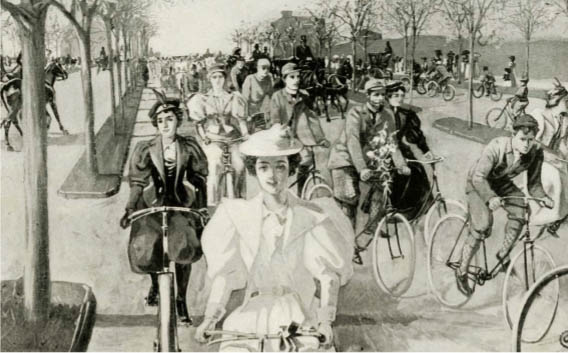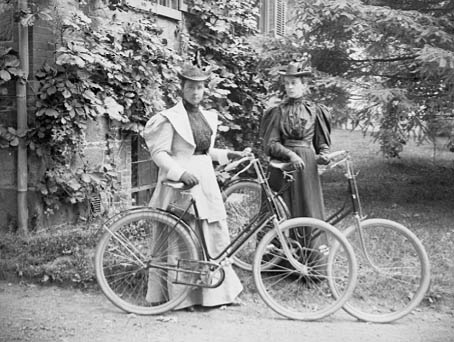CulBeat Express
2019.06.14 14:10
뉴욕시박물관 '사이클링 200년사'(Cycling in the City) 특별전(3/14-10/6)
조회 수 1440 댓글 0
Cycling in the City: A 200‐Year History
March 14 - October 6, 2019
Museum of the City of New York

New York Awheel―On the Riverside Drive, Near the Great Monument, Munsey’s Magazine, May 1896, Illustrator: J.M. Gleeson, Private collection
Cycling in the City: A 200–Year History, on view at the Museum of the City of New York from March 14, through October 6, 2019, will trace how the bicycle transformed urban transportation and leisure in New York City and will explore the extraordinary diversity of cycling cultures, past and present. It will reveal the complex, creative, and often contentious relationship between New York City and the bicycle, while underscoring the importance of cycling as the city confronts climate change, energy scarcity, and population growth in the years to come.
Cycling in the City, the first exhibition of its kind, will comprise more than 150 objects including 14 bicycles—spanning 1869 through today and presented on a stepped platform evocative of an historic velodrome, or cycle racing track—photographs, prints, and cycling apparel, as well as ephemera such as posters, magazines, brochures, and badges. The exhibition will also feature vintage and contemporary films projected on a large screen, a newly commissioned film of interviews with cycling advocates, and three indoor stationary bicycles that will enable visitors to experience virtual cycling landscapes via Zwift, an online‐based cycling videogame.
“The recent renaissance of cycling, as well as the 200‐year anniversary of the arrival of the first bicycle in New York City in 1819, makes this an opportune time to rediscover New York’s rich cycling heritage and foster discussion about the bicycle’s role in the metropolis—past, present, and future,” said Whitney W. Donhauser, Ronay Menschel Director and President of the Museum of the City of New York.
“Everything is bicycle.”
That is how author Stephen Crane described a cycle‐crazed New York City in 1896. The same could be said today. In recent years, bicycles have taken a major spot alongside motor vehicles and pedestrians in a reconfigured landscape of urban mobility. The statistics are staggering: according to the New York City’s Department of Transportation, more than 800,000 New Yorkers ride a bike regularly and 460,000 cycling trips are taken every day, triple the number 15 years ago.
And there are currently more than 100 miles of protected bike lanes, making New York City one of Bicycle Magazine’s top 10 cycling cities in the country. This success may come as a surprise since New York has had a complicated love‐hate relationship with the bicycle ever since the first velocipede appeared on the streets of the city in 1819. Generations have associated cycling in the city with danger—cyclists fear cars and pedestrians feel threatened by both. Although pedaling through the city’s crowded streets still comes with risks, cycling has become safer as the number of riders and miles of protected bike lanes have increased.
The bicycle continues to play an increasingly important role in today’s New York City, shaping what it means to live in a modern metropolis. Bicycles affect how we work, how we spend our leisure time, and how we define ourselves. The complex dance of cars, pedestrians, and bicycles continues to seek simple, speedy, healthy, and environmentally‐friendly ways to move about.
Cycling in the City will be organized thematically by three sections: Cycling Cultures, Cycling Machines, and Cycling Landscapes.

Portrait of Violet Ward and Daisy Elliot, c. 1895. Photograph by Alice Austen, Alice Austen House, Collection of Historic Richmond Town
*스태튼아일랜드 앨리스 오스틴 하우스 가이드
Cycling Cultures
“To men, the bicycle in the beginning was merely a new toy, another machine added to the long list of devices they knew in their work and in their play. To women, it was a steed upon which they rode into a new world.” –Munsey magazine, May 1896
This section will illustrate how New Yorkers have taken to their bicycles for many reasons: for transportation and exercise but also for personal liberation, self‐expression, and group identity. Over the last 200 years, city residents have created a variety of distinct bicycle subcultures, which reflect the diversity of these motivations and of the city itself. Not all of these cycling cultures have been viewed with approval; some have even met with resistance. Together, they have put themselves and their bicycles at the heart of larger cultural debates around gender, class, and ethnicity.
Cycling as liberation dates back to the late 19th century, when “New Women” followed the advice of suffragist Susan B. Anthony and embraced the bicycle as a vehicle of self‐reliance. Objects on view in this section will include a woman’s 19th–century biking costume, photographs by Alice Austen, who was an early bicycling advocate, and cartoons critiquing the “New Women” for their bicycling activity.
Other subcultures revolve around people who use their bicycles to make a living and provide an essential service to the city, such as messengers and delivery people. Sometimes ethnicity is key: bicycle clubs formed by Italian Americans and Puerto Ricans, among others, have used bicycles to express ethnic pride and solidarity. And the joy of riding fast has fueled racers, who have zoomed around Madison Square Garden, open‐air velodromes and parks, and through the streets.
Cycling Machines
“A legion of bicycle commuters is stirring in this city. Thousands of bicycles pulled from musty cellars and crowded closets have been dropped this week at the doorsteps of repair shops in the five boroughs…if there is a transit strike, a half million people may be pedaling to work.” –Robin Herman, The New York Times, March 26, 1980
This section will feature forms that bicycles have taken over the past 200 years following transformations in technology, riding cultures, and the city itself. The 14 machines that will be on view were designed to respond to people of different genders and classes, as well as to the varied needs of commuters, racers, messengers, and other cyclists.
The first human‐powered two‐wheeled machines, dubbed “velocipedes,” briefly appeared in New York in 1819. Without pedals, riders propelled themselves by pushing off the ground with their feet or coasting down hills. Pedal‐powered velocipedes became the rage in the late 1860s, when New York City was also the capital of the nation’s bicycle industry. Later in the 19th century, the smart set cruised through city parks on expensive, sometimes even jejeweled, bicycles and tricycles. By the end of the 19th century, so‐called safety bicycles with two equal sized wheels and a chain drive powering the rear wheel became the cycling machine norm, a basic design that persists
today.
Transformations of cycling machines have continued into the 20th and 21st centuries. Colorful and streamlined bikes lured children, fixed gear bikes served speedy messengers, pedicabs hauled people, and cargo bikes carried goods. Today, bike‐sharing serves the needs of commuters, “Made in Brooklyn” craft bikes attract stylish trendsetters, and folding bikes fit easily into city apartments and onto public transit. Cycling machines not only offer a way to move, but also a means to express the cyclists’ identities.
Cycling Landscapes
“Despised as bicycle messengers may be (by all but their employers) and dangerous as they are, they are fast becoming folk heroes—the pony‐express riders of the eighties.” –Dinitia Smith, New York Magazine, January 13, 1986
This section will show that one of the enduring issues faced by city cyclists, politicians, and planners has been figuring out where bicycles belong and where they do not. Negotiating how to weave the bicycle into the dense urban landscape has proven challenging—and often contentious. Advocates on various sides have sought to balance competing visions of the city, safety, environmentalism, and mobility. These debates go back to New York’s first cycling craze in the 19th century when cyclists successfully fought to earn the right to use roads and parks.
They spurred precedent‐setting urban innovations, including the creation of a bicycle path to Coney Island. Although cycling soon lost some of its early allure—its decline solidified by the rise of automobiles—by the 1930s enthusiasm for bicycling was reignited. The Depression highlighted bikes as an affordable alternative to cars, and the New Deal ushered in a vision of cycling as recreation, which promised to transform the city’s parks with one of the most ambitious bike infrastructure programs ever planned.
Urban bike innovation—and conflict—entered a new phase in the late 20th century as promotion of cycling as both recreation and transportation grew in the 1960s and early ‘70s, alongside the environmental movement. In the mid‐1960s, Mayor John V. Lindsay made Central Park more hospitable to bicycling by instituting car‐free hours, and some years later, cycling advocacy groups hosted pro‐bike rallies and tours. Both the city and new activist groups pushed New Yorkers to reconsider the bicycle as a legitimate form of transportation.
These efforts set the stage for bold and controversial actions in the 1980s. Early in that decade, Mayor Edward I. Koch urged New Yorkers to cycle during a transit strike. He also commissioned bicycle lanes in Manhattan, first defined with painted lines, later with concrete‐and‐asphalt barriers. When critics protested the barriers, Koch relented and the lanes were ripped out. But debates about where bicycles belonged on the streets only swelled. In 1987 Koch proposed banning bikes from Midtown Manhattan. Bicycle messengers, fighting for their livelihoods, protested through the streets, sued the City, and ultimately defeated the ban.
This activism paved the way for New York to become one of the most bicycle‐friendly cities in the United States. The transformation began during the mayoralty of Michael Bloomberg in the first decade of the 21st century and continues today under Mayor Bill de Blasio. Like the city itself, the streets and the bicycle’s place on them have changed dramatically over these years. Notably, the inauguration of Citi Bike in the spring of 2013 has not only increased the number of bicycles in use, but also the miles of protected bike lanes installed, and with new ones planned for the future.
Today, many New Yorkers have come to see the streets as also rightly belonging to cyclists. However, debates continue over the future of bike lanes, bike–share programs, and the place of the bicycle in an increasingly crowded city.
The exhibition is organized by Donald Albrecht, Curator of Architecture and Design at the Museum of the City of New York, and Evan Friss, Associate Professor of History at James Madison University, Virginia, and author of On Bicycles: A 200‐Year History of Cycling in New York City (Columbia University Press), with assistance from Susan Gail Johnson, Director of Publications and Senior Curatorial Associate at the Museum of the City of New York.
Cycling in the City: A 200‐Year History is made possible with lead support provided by Metropolitan Velodrome, Inc., with additional support provided by the Lily Auchincloss Foundation; Katheryn C. Patterson and Thomas L. Kempner Jr.; Bike New York; Rabobank International; and George H. Beane.
About the Museum of the City of New York
The Museum of the City of New York fosters understanding of the distinctive nature of urban life in the world’s most influential metropolis. It engages visitors by celebrating, documenting, and interpreting the city’s past, present, and future. To connect with the Museum on social media, follow us on Instagram and Twitter at @MuseumofCityNY and visit our Facebook page at Facebook.com/MuseumofCityNY. For more information please visit www.mcny.org.







